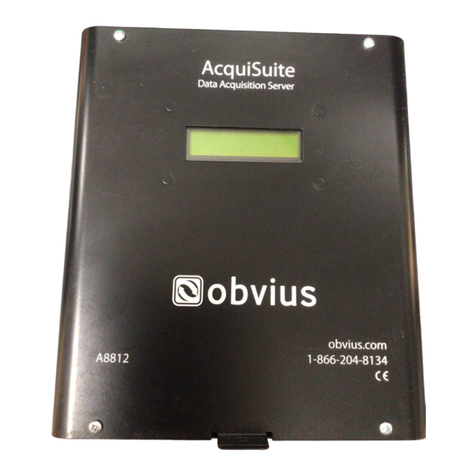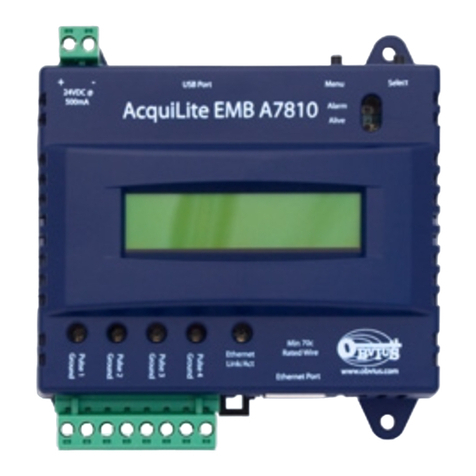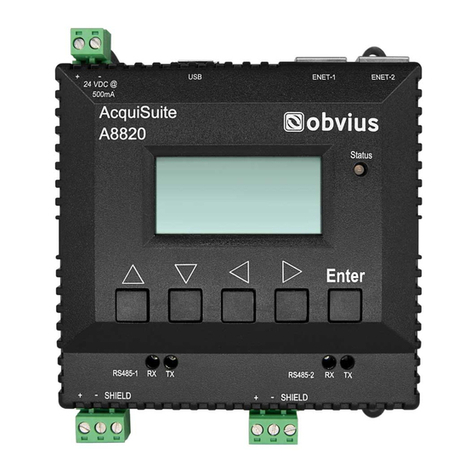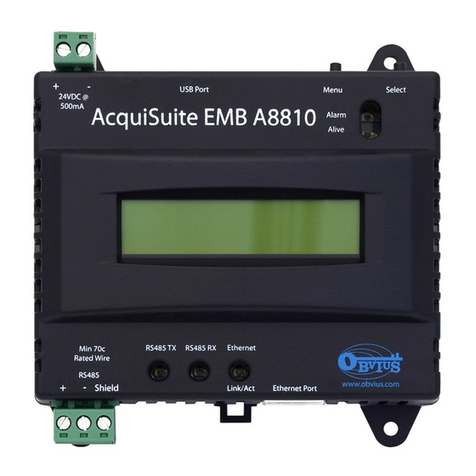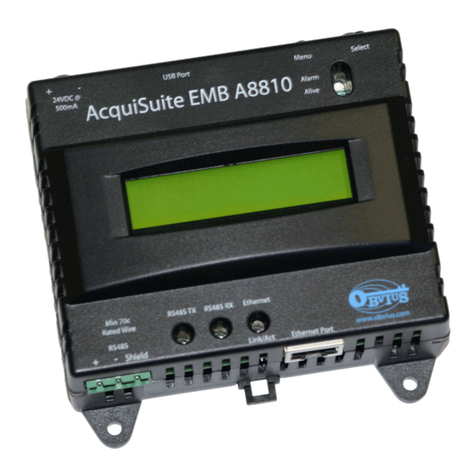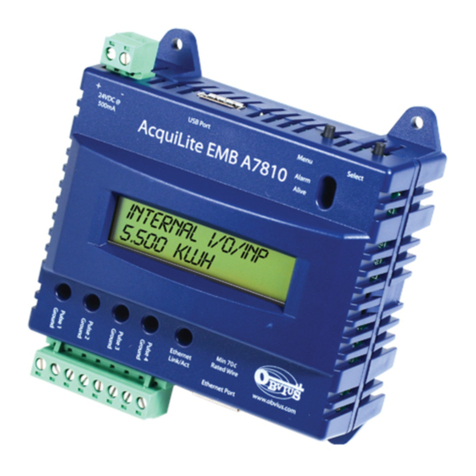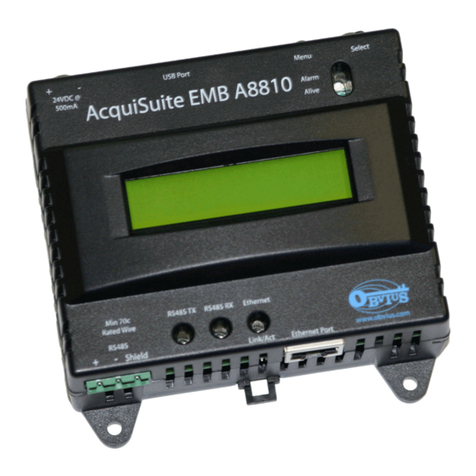
A8814 AcquiSuite+ Page 2
Copyright Information
Copyright © 2001 - 2013 by Obvius
Obvius and AcquiSuite are trademarks of Obvius Holdings LLc
Other brand and product names are trademarks or registered trademarks of their respective holders.
U.S. Government Restricted Rights: Use, duplication or disclosure by the Government is subject to restrictions set fourth in subparagraph (a) through (d)
of the Commercial Computer Restricted Rights clause at FAR 52.227-19 when applicable, or subparagraph (c) (1) (ii) of the Rights in Technical Data and
Computer Software clause at DFARS 252.227-7013, and in similar clauses in the NASA FAR Supplement.
Limited Warranty
Obvius provides this warranty for all its products in lieu of all other warranties (whether express or implied), including any implied warranty of
merchantability or fitness for a particular purchase. This warranty is the buyer’s exclusive remedy for all claims against Obvius. Obvius will not be liable for
any consequential or incidental damages and total liability shall be limited to the purchase price of the product.
Obvius promises buyer that any product manufactured by Obvius shall be free from all material defects in material or manufacture for a period of 2 years
from the date of sale. This warranty does not include ordinary wear and tear or replaceable components (e.g., batteries). During the warranty period,
Obvius will repair or replace (at its sole discretion) any product shown to be defective under this warranty at no charge to buyer. Returned freight prepaid
by buyer. The warranty shall remain in full force and effect for such 2 year period, provided that the product: (1) was installed, operated, and maintained
properly; (2) has not been abused or misused; (3) has not been repaired, altered, or modified outside of Obvius’ authorized facilities; (4) has not been sold
subject to other warranty terms specified at the time of sale; and (5) is still owned by the original purchaser. This warranty provides specific legal rights
that may be varied by state law. Obvius’ products are not intended for use in critical applications such as nuclear facilities, human implantable devices or
life support. Obvius is not liable, in whole or in part, for any claims or damages arising from such uses.
Obvius strongly believes in continuous improvement, therefore we must reserve the right to change specifications and product offerings without notice.
Where possible, we will substitute products with equivalent functionality when necessary.
Hazard of Electric Shock, Explosion or Arc Flash
●Follow safe electrical work practices. See NFPA 70E in the USA, or applicable local codes.
●This equipment must only be installed and serviced by qualified electrical personnel.
●Read, understand and follow the instructions before installing this product.
●Turn off all power supplying equipment before working on or inside the equipment. Use properly rated voltage sensing device to
confirm power is off. DO NOT DEPEND ON THIS PRODUCT FOR VOLTAGE INDICATION
●Only install this product on insulated conductors.
Failure to follow these instructions will result in death or serious injury.
A qualified person is one who has skills and knowledge related to the construction and operation of this electrical equipment and the
installation, and has received safety training to recognize and avoid the hazards involved. No responsibility is assumed by Obvius Holdings for
any consequences arising out of the use of this material.
RISK OF EQUIPMENT DAMAGE
AcquiSuite+ is rated for 50-60 HZ. Do not connect this product to circuits with high harmonic energy such as Variable Speed Drives
(a.k.a. Variable Frequency Drives, Adjustable Frequency Drives) or similar sources, as they may permanently damage the product.
This product is designed to work with 1V and 0.333V Current transformers (CTs). DO NOT USE CURRENT OUTPUT (e.g. 5A) CTs
on this product.
Failure to follow these instructions can result in overheating and permanent equipment damage.
●This product is not intended for life safety applications.
●Do not install this product in hazardous or classified locations.
●The installer is responsible for conformance to all applicable codes.
FCC Part 15 Information
Note: This equipment has been tested by the manufacturer and found to comply with the limits of a class A digital device, pursuant to part 15
of the FCC rules. These limits are designed to provide reasonable protection against interference when the equipment is operated in a
commercial environment. This equipment generates, uses, and can radiate radio frequency energy and, if not installed and used in
accordance with the instruction manual, may cause harmful interference to radio communications. Operation of this equipment in a residential
area is likely to cause harmful interference in which case the user will be required to correct the interference at his own expense.
Modifications of this product without the express authorization of Obvius nullify this statement.
